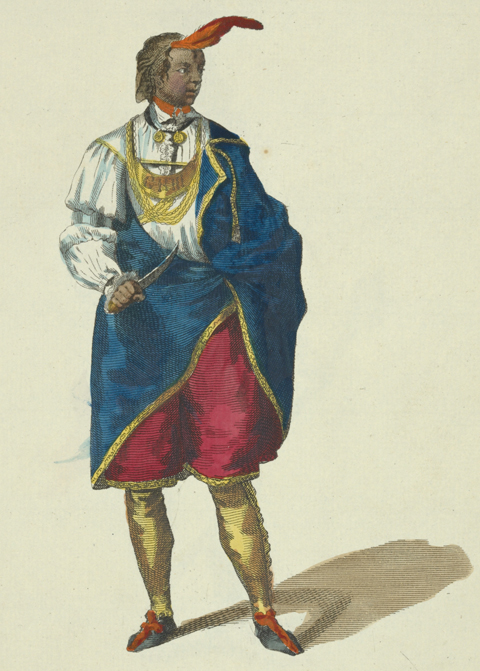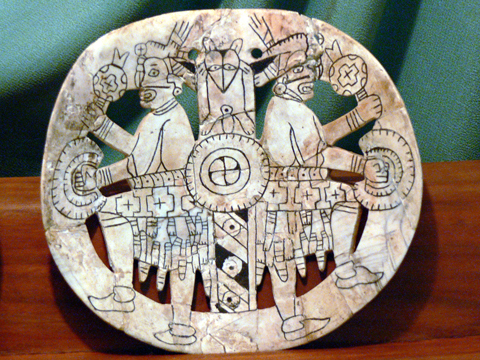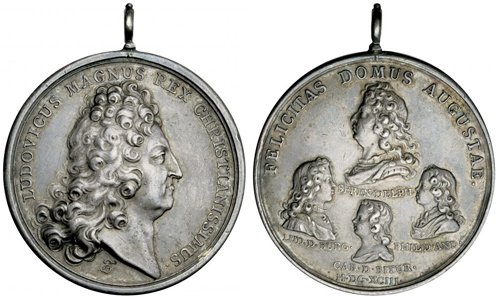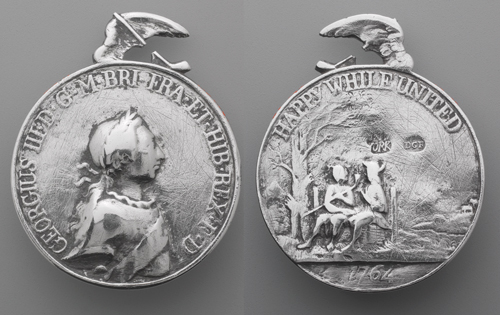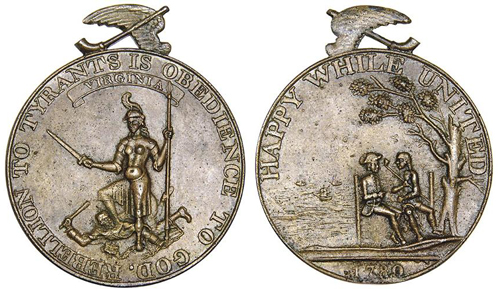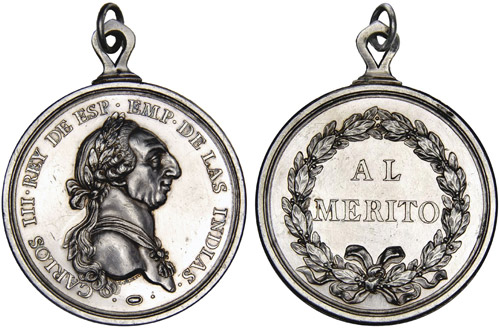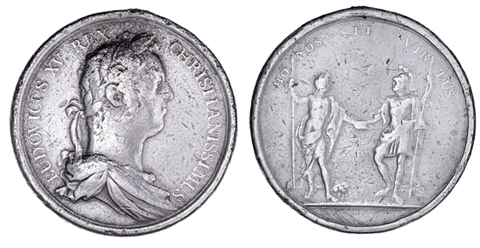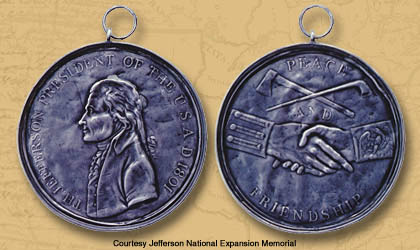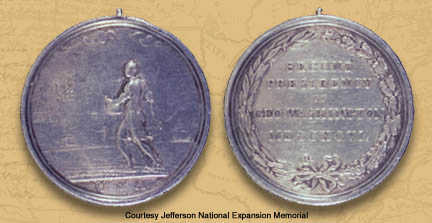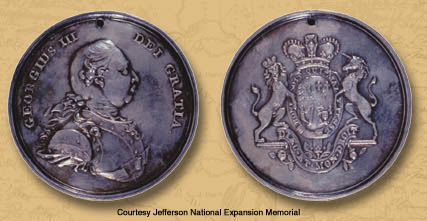Figure 1
Habit of Cunne Shote a Cherokee Chief[1]The Miriam and Ira D. Wallach Division of Art, Prints and Photographs: Art & Architecture Collection, The New York Public Library. “Habit of Cunne Shote a Cherokee Chief. Cunne Shote Chèf … Continue reading
(Stalking Turkey)
Artist: James McArdell (ca. 1729-1765).
In his analysis of a painting contemporaneous with the one shown here, Duane King identifies the two peace medals worn by Cunne Shote: A Proclamation Medal of King George III and the Wedding Medallion of King George III and Queen Charlotte. Below the medals is a gorget inscribed “GR III.” All three items were British and likely gifts received during a visit of three Cherokee diplomats in England in 1762.[2]Duane H. King, “British Medals Depicted in Cherokee Portraits of 1762” in Peace Medals: Negotiating Power in Early America, ed. Robert B. Pickering. (Tulsa, Oklahoma: Gilcrease Museum), … Continue reading
For many decades before the American Revolution, the instruments of diplomacy that the rulers of civilized nations had relied on in dealing with the native occupants of the lands they claimed, were gifts of Indian Presentation Flags; printed certificates called Indian commissions or paroles; clothing such as cloaks, blankets or military dress uniforms; engraved silver pipes and silver-headed canes; silver gorgets (small decorative breastplates); and medals. By far the most important were the gifts called “peace medals,” because the giving and the receiving of the token signified an understanding that the parties would maintain peaceable relationships with one another and with their neighbors, in the interest of free and profitable commerce, at least to the foreigners instead of their foreign competitors. Some Indians tended to believe that a medal was a guarantee of the giver’s military support against their own native rivals and enemies.
The symbolism of the king’s or president’s likeness, and of the images on the reverse, were powerful in themselves, but to recipients without written languages, the representations of words undoubtedly bore the potency of “strong medicine.” Yet in the latter regard, American peace medals were far simpler and more direct than contemporary British or Spanish medals.
In 1793, when he was Secretary of State under President Washington, Thomas Jefferson wrote to the American commissioners to Spain in Madrid:
Giving medals and marks of distinction to the Indian chiefs . . . has been an ancient custom from time immemorial. The medals are considered as complimentary things, as marks of friendship to those who come to see us, or who do us good offices, conciliatory of their good will towards us, and not designed to produce a contrary disposition towards others. They confer no power, and seem to have taken their origin in the European practice, of giving medals or other marks of friendship to the negotiators of treaties and other diplomatic characters, or visitors of distinction. The British government, while it prevailed here, practiced the giving medals, gorgets, and bracelets to the savages, invariable. We have continued it, and we did imagine, without pretending to know, that Spain also did it.[3]Thomas Jefferson to William Carmichael and William Short, the U.S. Commissioners to Spain, 30 June 1793. Paul Leicester Ford, ed., Writings of Thomas Jefferson, 10 vols. (New York: G. P. … Continue reading
Commissions
In keeping with the accepted Euro-American policy of putting contracts in writing, signing, and sealing them, each peace medal given out was usually accompanied by a commission, also called a parole, which is the French word for promise. A parole guaranteed universal peace and friendship between the recipient and all other persons, Indian or American, represented by the signators. It also attested, implicitly, that the recipient was an official representative and chief of his band or tribe, a false and unfair assumption that remained at the core of troubled Indian-white relations for most of the nineteenth century.
Over time, the diplomatic gifts in style—at least in the Indians’ eyes—depended on the nation making the best promises. Early French medals were replaced by British and Spanish medals, and Meriwether Lewis and William Clark were intent on replacing those with United States medals. These diplomatic overtures continued through the War of 1812 and into the late fur trade.
Figure 2
Replica Shell Gorget
Spiro Site, Oklahoma
Woolaroc Museum. Photo by Wolfgang Sauber. Usage governed by the Creative Commons Attribution-Share Alike 3.0 license.
Spiro Mounds is an archaeological site in present Eastern Oklahoma. The site reflects the Mississippian Culture that thrived here before European contact.
Gorgets
Pre-contact Shell Gorgets
Before European contact, the gorget served a purpose similar to the peace medals that would come later. These were most common during the Woodland Period in Eastern America, 1000 BCE to 1000 CE and Mississippian Period, 800CE to 1600 CE. These adornments were often round, or oval, and carved from shells. Reilly states that “These shell gorgets carried intrinsic supernatural power, as well as serving as explicit badges denoting membership in larger affinity groups.”[4]F. Kent Reilly III, “Displaying the Source of the Sacred, Shell Gorgets, Peace Medals, and the Accessing of Supernatural Powers” in Peace Medals: Negotiating Power in Early America, ed. … Continue reading
Similar to the peace, early gorgets were round or oval and typically worn below the neck as regalia. They also featured strong images of leaders.
Expedition Gorgets
In the 15th century, the word gorget denoted a piece of armor protecting the throat.[5]Smyth, Sailor’s Word-Book, s.v. This definition aligns with Clark’s gift of a shell gorget in exchange for services:
Collected all our horses, & Branded them 38 in No. and delivered them to the men who were to take Charge of them, each of which I gave a Knife & one a wampon Shell gorget . . . .
The above exchange occurred 5 October 1805, at the Clearwater Canoe Camp. It was not a diplomatic gift, but a payment to the Nez Perce men who agreed to tender the Expedition’s horses while the Expedition continued by boat to the Pacific Ocean.
By the time of the Lewis & Clark Expedition, a gorget more commonly referred to a crescent-shaped badge or necklace made of metal and often worn by an officer on duty. Cunne Shote is shown in Fig. 1 wearing a British military gorget of the type Lewis and Clark were replacing. Lewis and Clark gave these metal gorgets to chiefs to signify equal status between themselves and tribal war-chiefs. For example, on 9 March 1805, while wintering at Fort Mandan, Clark records:
found the Manitarree Chief about Setting out on his return to his village, having recieved of Captain M. Lewis a medel Gorget armbans, a Flag Shirt, Scarlet &c. &c. &c. for which he was much pleased . . .
Figure 3
1693 Family Medal of Louis XIV
Silver, 41.2mm diameter. Courtesy of Stack’s Bowers Galleries, stacksbowers.com)
The obverse displays the bust of King Louis XIV with the words “LUDOVICUS MAGNUS REX CHRISTIANISSIMUS” (Christian King Louis the Great). On the reverse, is the bust of the King’s eldest son and his three children. The text “FELICITAS DOMUS AUGUSTAE” roughly translates to Fortune House Augustae.
Spanish Peace Medal
Figure 6
Tomàs Prieto’s (1716–1782) AL MÉRITO
Silver, 55.5mm diameter. Courtesy of Stack’s Bowers Galleries, stacksbowers.com).
The silver Al Mérito medal, both large and small, was gifted to the American Indian by the Spanish. They were widely dispersed through most of the present United States including the Louisiana Territory and Pacific Northwest regions explored by the Lewis and Clark Expedition.[6]Barry D. Tayman, et al., “Tomás Prieto’s Al Mérito Spanish Indian Peace Medals” in Peace Medals: Negotiating Power in Early America, ed. Robert B. Pickering. (Tulsa, Oklahoma: … Continue reading
The obverse is a portrait of the Spanish king with the text: CARLOS III • REY DE ESP • EMP • DE LAS INDIAS (Charles III, King of Spain, Emperor of the Indies). The reverse is the text AL MERITO (Merit).
Figure 7
Louis XV Honus et Virtu Medal
American Numismatic Society MANTIS database, http://numismatics.org accessed on 10 February 2017, licensed under the Creative Commons Attribution-NonCommercial 4.0 International License.
This weathered example features the bust of Louis XV on the obverse with the words LUDOVICUS XV. REX CHRISTIANISSIMUS, Louis 15. Christian King. The reverse is inscribed HONOS ET VIRTUS, honor and virtue, and depicts two allegorical figures joining hands.
Early Peace Medals
First the French
French peace medals were introduced to the American Indians by French fur traders working mainly in present Canada. Two early known examples were the 1693 Family Medal of Louis XIV and the gift of a 1722 Louis XV Coronation medal to a Huron chief. The Louis XIV medal was the typical gift in the beginning of Louis XIV’s reign. Medals of the Louis XV Honos et Virtu design (See Fig. 7) were actively distributed in the first half of the 18th-century—up to the time Canada fell to the British in 1760.[7]John W. Adams, “The Indian Peace Medals of Louis XV” in Peace Medals: Negotiating Power in Early America, ed. Robert B. Pickering. (Tulsa, Oklahoma: Gilcrease Museum), 33–35.
For the Indians, the transition from gorgets to peace medals was rational. Reilly explains:
The peace medals, like the earlier shell gorgets, directly associated the wearer with the real power of the individual whose image was impressed on the medal’s surface. For the Native American wearers, the peace medal, with its royal and later republican American imagery, served to guarantee access to the technological wonders of the rifle, as well as other types of European and later American trade goods.[8]F. Kent Reilly III, “Displaying the Source of the Sacred, Shell Gorgets, Peace Medals, and the Accessing of Supernatural Powers,” in Peace Medals: Negotiating Power in Early America, ed. … Continue reading
Second the British
After the French and Indian war ended in 1763, Indian leaders in the Great Lakes area began asking the British to replace their now obsolete French flags, certificates, and medals. To meet demand, early medals, of the “Happy While United” medals were made in colonial New York City and widely distributed.[9]Duane H. King, “British Medals Depicted in Cherokee Portraits of 1762,” in Peace Medals: Negotiating Power in Early America, ed. Robert B. Pickering. (Tulsa, Oklahoma: Gilcrease Museum), … Continue reading
Shortly after the United States gained independence from Great Britain, the Happy While United design was modified. Thomas Jefferson and others planned to establish treaties with Indians in the new State of Virginia. The 1780 medal was clearly a peace medal, but no treaties are known to have been created.[10]Adams, The Virginia Happy While United Medal, American Journal of Numismatics, (3/4 1992 http://www.jstor.org/stable/43580426 accessed on 13 February 2017), 123. The reverse on both the British and United States versions picture a white person smoking a peace pipe with a Native American under the text HAPPY WHILE UNITED. On the obverse, the figure of the King George III, considered a tyrant by most American colonists, was replaced with a soldier standing triumphantly over a slain enemy. The text was changed to REBELLION TO TYRANTS IS OBEDIENCE TO GOD. Below that, in small letters, is Virginia. A variation of this image is still used in Virginia’s state seal.
Third the Spanish
After France ceded Louisiana to Spain in 1762, the Spanish government began using medals to consolidate their interests among Indians throughout the territory. They made their medals especially meaningful by distributing them purposely through their official agents, who were licensed traders. The distribution of medals was not without risks, even with the best of intentions. For instance, the Lieutenant Governor of Spanish Illinois wrote to the Governor at New Orleans in 1776 that he had incurred the displeasure of some Little Osage Indians, who had expected to be given medals:
According to the custom already established, it is more usual to give the medal to the first in rank and there is really no reason why he should be denied it. In giving it to both of them there would arise the inconvenience of the second chiefs of the other nations having reason to expect the same. Depriving the second of the medal and giving it only to the first, I would have as a result of his displeasure, censure, and jealousy, the stealing of horses from the inhabitants of the neighboring towns, and the insulting of the traders. That is why I have refrained from offending either of them.[11]Joseph Kinard, ed., Spain in the Mississippi Valley, 1765-1794. Annual Report of the American Historical Association (Washington, D.C., 1945), I, 229-230. Cited in Prucha, Indian Peace Medals, p. 13.
As a step toward combatting the inroads made with the Indians in the northern part of Upper Louisiana, the Spanish established the Company of Explorers of the Upper Missouri, known as the Missouri Company, in 1794-95. But whereas Lewis and Clark were at liberty to hand out peace medals at their own discretion, and were not obliged to account for them, only a territorial governor had the power to authorize the awarding of a medal to any Indian, and even Lieutenant Governor Zenon Trudeau, in St. Louis, had difficulty getting enough medals from Governor Carondelet for the agents of the Missouri Company such as Jean Baptiste Truteau, James Mackay (a Scotsman who took up Spanish citizenship), and the Welshman John Evans. They would have distributed Charles III medals, of course.[12]Francis Paul Prucha, Indian Peace Medals in American History (Lincoln: University of Nebraska Press, 1971), 11-16.
Related to the Lewis and Clark Expedition, one of the few surviving Al Mérito medals is in the Missouri Historical Society collections. That medal was owned by Charles Dehault Delassus, the Spanish lieutenant governor of Upper Louisiana who, with Meriwether Lewis as chief official witness, transferred the upper Louisiana to the United States on 9 March 1804 at St. Louis.[13]Tayman, 28. [14]See also The Louisiana Purchase.
Fourth, the United States
Given that existing loyalties between American Indian and European nations included treaties, peace medals, gorgets, and commissions, it is only natural that the newest country—the United States of America, especially in its newly acquired Louisiana Territory—needed to replace the earlier—and now foreign—diplomatic gifts with their own. As discussed in the following pages, the young United States, represented by Captains Lewis and Clark, did indeed actively pursue this goal.
Medals were manufactured in several different ways, but most were stamped or “struck” in a soft metal such as silver, using an engraving or “die” cast or carved from a harder metal. Because of limitations in American technology at the turn of the 19th century, all the Jefferson medals were stamped in sheet silver, and the two parts—front and back (obverse and reverse)—were held together by a silver band. The artisan who created the Jefferson medals was an immigrant German “die sinker” named John Reich, who was employed at the U.S. Mint in Philadelphia, where the work had to be done during noon hours and at night so as not to interfere with the minting of coins. The average cost per medal was $7.60, a considerable sum for that time. Beginning with the administration of Jefferson’s successor, President James Madison, medals were made of solid silver, but the basic design, as well as the wording, remained essentially the same until peace medals became irrelevant in the early 1880s owing to the failure of the givers to hold up their end of the bargain.
Henry’s report from Mandans, 1806
Alexander Henry the Younger, a fur trader with the Northwest Company, visited the Mandan and Hidatsa villages in late July 1806, a few weeks before Lewis and Clark passed through on their way home, and recorded the Hidatsas’ impressions of the Americans’ diplomacy.
“In 1804–05, when Captains Lewis and Clark wintered near this place, they presented the people with silver medals and flags, the same as they gave to the Mandanes; but the Big Bellies [Hidatsas] pretended to say that these ornaments conveyed bad medicine to them and their children. They are exceedingly superstitious, and, therefore, supposed they could not better dispose of those articles than by giving them to the natives with whom they frequently warred, in hope the ill-luck would be conveyed to them. They were disgusted at the high-sounding language the American captains bestowed upon themselves and their own nation, wishing to impress the Indians with an idea that they were great warriors, and a powerful people who, if exasperated, could crush all the nations of the earth, etc.”[15]Elliott Coues, ed., New Light on the Early History of the Greater Northwest (1987; reprint, 3 vols., New York: Harper, 1897), I, 349–50. See also Elliott Coues, ed., The History of the Lewis and … Continue reading
Jefferson Peace Medals
The Expedition Inventory
On 17 August 1805, among Sacagawea‘s people, the Lemhi Shoshones, Meriwether Lewis recorded giving two type of medals—The Jefferson Peace Medal and Washington Season Medals:
We next inquired who were chiefs among them. Cameahwait pointed out two others whom he said were Chiefs. We gave him a medal of the small size with the likeness of Mr. Jefferson, the President of the U’ States, in relief on one side and clasped hands with a pipe and tomahawk on the other. To the other Chiefs we gave each a small medal . . . which were struck in the Presidency of George Washington, Esqr. We also gave small medals of the last description to two young men whom the 1st Chief informed us were good young men and much respected among them.
Lewis and Clark carried a total of at least eighty-nine peace medals in five different sizes:
- 3 large Jefferson medals about 105 mm (4.13 in.) in diameter
- 13 Jefferson medals about 76 mm (2.95 in.) in diameter
- 16 Jefferson medals about 55 mm (2.17 in.) in diameter
- 55 “season” medals, 45 mm (1.77 in.) in diameter
- 2 (or 4?) “medals of the fifth size,” of unknown size
Expedition Gifts
All but one were more or less formally presented to Indians they met along the way, mainly to individuals who were apparently tribal leaders. When in doubt, the captains arbitrarily “made” chiefs, a practice that backfired when misjudgment resulted in intratribal jealousy, and once when they gave a medal to the Lakota Sioux chief, Torto-hongar (the “Partisan”) before they realized he was “a great scoundrel.”[16]“Partisan” was a nickname given the fractious Brulé Sioux leader by white traders. Another Sioux chief called him “a Double Spoken man” (Journals, 28 September 1804). A Cheyenne chief so honored by Clark on 21 August 1806, returned his medal with the explanation that “he was afraid of the midal or any thing that white people gave to them.” Clark successfully prevailed, however, informing the reluctant Cheyenne that “this was the medecene which is Great father directed me to deliver to all the great Chiefs who listened to his word and followed his councils.”[17]On that date Sergeant Patrick Gass recorded: “Captain Clarke gave one of their chiefs a medal, which he gave back with a buffaloe robe, and said he was afraid of white people, and did not like … Continue reading Hidatsas were known to have given their medals to their enemies in the expectation that the bad medicine would fall upon them instead (see sidebar).
The first medals were given to Oto and Missouri leaders on 3 August 1804, including “a package with a meadile to accompany a Speech for the Grand Chief” who was absent. The speech possibly was delivered in person, in behalf of the captains, by the Frenchman known only as “Faufong the interpeter,” who lived with the Otoes.[18]The variety of spellings in which Clark strove to capture this man’s name–Far fonge, Fairfong, Faufong, Faufon, and Fauforn–may have reflected Clark’s own confused impressions from … Continue reading One wonders whether it mightn’t have lost something in a translation by a disinterested third party.
Among the last to be given were two that went to Nez Perce leaders. One of them, “a medal of the small kind with the likeness of Mr. Jefferson,” went to a leader named Tunnachemootoolt, known to the Americans as “Broken Arm.” On the same day, 10 May 1806, “a Chief of great note”–Hohots Ilppilp–of the Nez Perce (Ni-mee-poo) nation, received “one of the sewing [i.e., “season”] medals struck in the presidency of Washington.” Lewis explained to them “the desighn and the importance of medals in the estimation of the whites as well as the red men who had been taught their value.” It is likely that the captains learned quite a bit during the 31 months since August of 1804 about how to talk to native leaders about allegiances and other, less militant concepts such as civilized democratic government, and agriculture. Unfortunately for us, the captains’ record-keeping on this matter was generally haphazard and incomplete, and they provided no comprehensive report to the Secretary of War enumerating the chiefs they had “made.”
Ironically, Lewis left a peace medal around the neck of the Piegan Indian whom Reuben Field killed in self defense beside the Two Medicine River in northwest Montana on 17 July 1806, so that the victim’s tribesmen would know who was responsible. (See Fight on the Two Medicine.)
All of the Jefferson medals had been given away by the time the Corps returned to the Nez Perces in May of 1806. The captains had reserved a Jefferson medal of the largest size (105 mm) for “some great Chief of the Yellow rock river,” but Clark did not encounter any Indians along the Yellowstone, so it was taken back to St. Louis. No one knows what became of it then. At least seven Jefferson medals and two Season medals of the type given away by Lewis and Clark have been found, and are in various museums and private collections throughout the U.S., although several of those are now missing. Also, it is possible that one or more of the Jefferson medals may be restrikes that found their way to Indian hands years after the expedition.
The George III medal features an august image of the American colonists’ nemesis, George William Frederic, of the German house of Hanover, who was king of England, Scotland, Ireland, and the far-flung British Empire, from 1760 until 1814. The obverse (left) of the 76-millimeter disc reads “Georgius III, Dei Gratia”—”George the Third, By the Grace of God.”
On the reverse (right) is the elaborate royal coat of arms. One wonders just how, or even whether, the ancient and arcane principles of heraldry managed to clamber over the linguistic and cultural barriers that separated Briton from Indian. Would the power and might of the symbolically-crowned lion, representing the medieval house of Plantaganet, be recognized as a counterpart of the Indians’ grizzly bear? What did the Indians think of the unicorn depicted on the right side of the reverse, or the principle of “purity” it was supposed to represent?[19]Many Euro-Americans still expected to find unicorns somewhere in the West. In 1804, William Dunbar, a Scottish scientist who had settled in Natchez, Mississippi, encouraged Thomas Jefferson to send … Continue reading How would the 14th-century origins of the Order of the Garter be explained, or that chivalric admonition, Honi soit qui mal y pense—”Shamed be he who thinks evil of this.” And how many different interpretations might a British trader have invented from that abbreviated French motto, Dieu et Mon Droit—”God, and My Right”? Would he have tried to defend the king’s “divine right” to rule?
Verily, there was enough content in King George’s shiny little gift, chock full of history and symbolism, to fill a whole evening’s harangue with stories and explanations. By comparison, the messages inherent in the frankly didactic Jefferson and Season medals certainly must have sounded simpler, if perhaps less wondrous.
Washington Season Medals
The first American presidential peace medals were created for President George Washington during his first term in office. Since the young nation did not have the craftsmen nor the tools to produce medals from dies, they were individually engraved in solid silver. Oval in shape, some were as large as 5-1/4″ high by 7-1/4″ wide (132 by 180 millimeters).
During Washington’s second term a special set of three medals was designed by John Trumbull (1756-1843), one of the leading American artists of the Revolutionary Era. They came to be called “Season” medals, even though their subjects were not the seasons per se.
One of Trumbull’s designs, sometimes called the “Wheat” or “Sower” medal, is pictured above. At left is the front, or obverse side. In the foreground, at right of center, a man sows grain on land labeled—beneath the soil’s surface—”U.S.A.” In the background, too faint to be discerned in this photograph, another man is plowing near a small house, which is surrounded by a fence.Trumbull’s aim was to “characterize the first steps in agriculture.” On the reverse face the words “Second Presidency of Geo: Washington MDCCXCVI [1796]” are wreathed by an olive branch (left) representing peace and prosperity, and another of oak leaves (right), standing for strength and loyalty. A ribbon—ideally a yellow one—binds the two branches together.
Two other medals in the “Season” series depicted animal husbandry and domestic occupations (spinning, weaving, child-rearing) to convey the idea of rural domestic tranquility and occupation. All three were calculated to encourage Indian recipients to adopt a “civilized” American life-style. However, Indians generally preferred medals featuring the image of a king or president.
Still lacking wherewithal in this country, the government had the Season medals struck in Birmingham, England. A total of 700 medals, each 45 mm in diameter, were ordered, but the only shipment of record, containing just 326 medals, arrived in July of 1798, seven months into John Adams’s administration. That there was still an ample supply of them available in 1803 is suggested by the fact that Lewis requisitioned fifty-five of them from the Secretary of War to supplement his supply of Jefferson peace medals.
Lewis and Clark distributed a total of 55 Season medals among the Indian leaders they met.
Peace Medal Wars
Early Warnings
Lewis and Clark often took pains to explain to Indian recipients “the design and the importance of medals in the estimation of the whites as well as the red men who had been taught their value.”[20]10 May 1806, at Long Camp near a Nez Perce village on the Clearwater River. Among the tribes along the lower Missouri River they also advised chiefs “to impress it on the minds of their nations” that medals and flags were not to be accepted from British representatives, “without they wished to incur the displeasure of their Great American Father.” They even warned young François-Antoine Larocque, a clerk for the North West Company who they met during the winter at Fort Mandan, not to give British medals and flags to Indians in U.S. territory, but Larocque said he had no such intention.[21]See also Larocque at Fort Mandan.
War of 1812
During the War of 1812 British authorities in Canada mounted a vigorous campaign, through their licensed traders in upper Louisiana, to restore their own medals to the hands of the Indians, and take away the American models Lewis and Clark, Zebulon Pike and others had so freely given. So effective were the British efforts that American authorities were still trying to restore the right medals to Indian hands twenty years after winning the war.
Clark’s 1829 Policy
In 1829, while Clark was Indian Agent for Upper Louisiana, he and Lewis Cass, Governor of the Territory of Michigan, together recommended a policy for the distribution of medals and flags, to reaffirm traditional practice and avoid misuse by new government agents.
- They will be given to influential persons only.
- The largest medals will be given to the principal village chiefs, those of the second size will be given to the principal war chiefs, and those of the third size will be given to the less distinguished chiefs and warriors.
- They will be presented with the proper formalities, and with an appropriate speech, so as to produce a proper impression upon the Indians.
- It is not intended that chiefs should be appointed by any officer of the department, but that they should confer these badges of authority upon such as selected or recognized by the tribe, and as are worthy of them, in the manner heretofore practiced.
- Whenever a foreign medal is worn, it will be replaced by an American medal, if the Agent should consider the person entitled to a medal.[22]Report of Cass and Clark, 10 February 1829, Senate Document No. 72, 20 Congress, 2 session, serial 181, pp. 77-78. Quoted in Prucha, Indian Peace Medals, xiii.
Obviously, Clark had learned some lessons from his experience of twenty-five years before.
References
Francis Paul Prucha, Indian Peace Medals in American History (Lincoln: University of Nebraska Press, 1971).
Paul Russell Cutright, “Lewis and Clark Indian Peace Medals,” Missouri Historical Society Bulletin, XXIV (January, 1968), 160-67.
Robert B. Pickering, ed. Peace Medals: Negotiating Power in Early America (Tulsa, Oklahoma: Gilcrease Museum, 2011).
An interesting history of the people Clark called a “Great Nation who the French has given the nickname of Sciouex,” is Royal B. Hassrick’s The Sioux: Life and Customs of a Warrior Society (Norman: University of Oklahoma Press), 1964. That nickname represents the sound of the last syllable of their nation’s name for themselves.
—This page made possible with generous assistance from Bob Moore, historian, Jefferson National Expansion Memorial, Bonnie Bowler, and Barry D. Tayman.
Notes
| ↑1 | The Miriam and Ira D. Wallach Division of Art, Prints and Photographs: Art & Architecture Collection, The New York Public Library. “Habit of Cunne Shote a Cherokee Chief. Cunne Shote Chèf des Chiroquois.” (New York Public Library Digital Collections), http://digitalcollections.nypl.org/items/510d47e4-81c9-a3d9-e040-e00a18064a99. Accessed 9 February 2017. |
|---|---|
| ↑2 | Duane H. King, “British Medals Depicted in Cherokee Portraits of 1762” in Peace Medals: Negotiating Power in Early America, ed. Robert B. Pickering. (Tulsa, Oklahoma: Gilcrease Museum), 42–45. See Chapter five for much more of the story behind the Cherokee delegation and to view Francis Parsons’ portrait of Cunne Shote. That painting prominently displays the two peace medals and gorget. |
| ↑3 | Thomas Jefferson to William Carmichael and William Short, the U.S. Commissioners to Spain, 30 June 1793. Paul Leicester Ford, ed., Writings of Thomas Jefferson, 10 vols. (New York: G. P. Putnam’s Sons, 1892-99), 6:336. |
| ↑4 | F. Kent Reilly III, “Displaying the Source of the Sacred, Shell Gorgets, Peace Medals, and the Accessing of Supernatural Powers” in Peace Medals: Negotiating Power in Early America, ed. Robert B. Pickering. (Tulsa, Oklahoma: Gilcrease Museum), 11. |
| ↑5 | Smyth, Sailor’s Word-Book, s.v. |
| ↑6 | Barry D. Tayman, et al., “Tomás Prieto’s Al Mérito Spanish Indian Peace Medals” in Peace Medals: Negotiating Power in Early America, ed. Robert B. Pickering. (Tulsa, Oklahoma: Gilcrease Museum), 19. |
| ↑7 | John W. Adams, “The Indian Peace Medals of Louis XV” in Peace Medals: Negotiating Power in Early America, ed. Robert B. Pickering. (Tulsa, Oklahoma: Gilcrease Museum), 33–35. |
| ↑8 | F. Kent Reilly III, “Displaying the Source of the Sacred, Shell Gorgets, Peace Medals, and the Accessing of Supernatural Powers,” in Peace Medals: Negotiating Power in Early America, ed. Robert B. Pickering. (Tulsa, Oklahoma: Gilcrease Museum, 17). |
| ↑9 | Duane H. King, “British Medals Depicted in Cherokee Portraits of 1762,” in Peace Medals: Negotiating Power in Early America, ed. Robert B. Pickering. (Tulsa, Oklahoma: Gilcrease Museum), 48. |
| ↑10 | Adams, The Virginia Happy While United Medal, American Journal of Numismatics, (3/4 1992 http://www.jstor.org/stable/43580426 accessed on 13 February 2017), 123. |
| ↑11 | Joseph Kinard, ed., Spain in the Mississippi Valley, 1765-1794. Annual Report of the American Historical Association (Washington, D.C., 1945), I, 229-230. Cited in Prucha, Indian Peace Medals, p. 13. |
| ↑12 | Francis Paul Prucha, Indian Peace Medals in American History (Lincoln: University of Nebraska Press, 1971), 11-16. |
| ↑13 | Tayman, 28. |
| ↑14 | See also The Louisiana Purchase. |
| ↑15 | Elliott Coues, ed., New Light on the Early History of the Greater Northwest (1987; reprint, 3 vols., New York: Harper, 1897), I, 349–50. See also Elliott Coues, ed., The History of the Lewis and Clark Expedition (4 vols., 1893; reprint, 3 vols., New York: Dover, n.d.), III:1191–92n. |
| ↑16 | “Partisan” was a nickname given the fractious Brulé Sioux leader by white traders. Another Sioux chief called him “a Double Spoken man” (Journals, 28 September 1804). |
| ↑17 | On that date Sergeant Patrick Gass recorded: “Captain Clarke gave one of their chiefs a medal, which he gave back with a buffaloe robe, and said he was afraid of white people, and did not like to take anything from them: but after some persuasion he accepted the meadal, and we left them.” |
| ↑18 | The variety of spellings in which Clark strove to capture this man’s name–Far fonge, Fairfong, Faufong, Faufon, and Fauforn–may have reflected Clark’s own confused impressions from one source, but one suspects they really represent his auditory impressions of several other speakers who attempted to help him out. The captains first met him at their Council Bluff camp on 2 August 1804. Evidently he stayed with them for some 200 miles upriver, when they paid him for his services and left him behind on the 20th, a few hours before Private Floyd died. Whatever his name was, he gave them some important geographical information about travel time (25 days) from Council Bluff to Santa Fe. Moulton, Journals, 2:439, 442 note 5. |
| ↑19 | Many Euro-Americans still expected to find unicorns somewhere in the West. In 1804, William Dunbar, a Scottish scientist who had settled in Natchez, Mississippi, encouraged Thomas Jefferson to send an exploratory expedition up the Red River of the South with promises of “wonderful productions,” including unicorns, whose existence had reportedly been observed in today’s central Oklahoma early in the eighteenth century. See Dan Flores, Jefferson & Southwestern Exploration (Norman: University of Oklahoma Press, 1984), pp. 14, 15, 17 n., 19, 277, 277 n. 279. The quixotic General James Wilkinson also passed along to Jefferson the old rumors of unicorns’ existence in the Southwest. See Dan Flores, The Freeman-Custis Expedition, “Spanish Misgivings.” |
| ↑20 | 10 May 1806, at Long Camp near a Nez Perce village on the Clearwater River. |
| ↑21 | See also Larocque at Fort Mandan. |
| ↑22 | Report of Cass and Clark, 10 February 1829, Senate Document No. 72, 20 Congress, 2 session, serial 181, pp. 77-78. Quoted in Prucha, Indian Peace Medals, xiii. |
